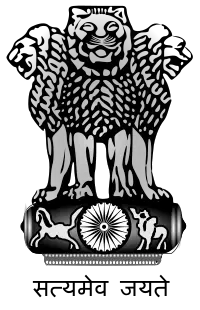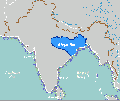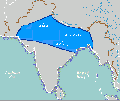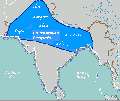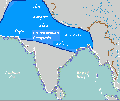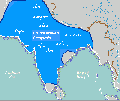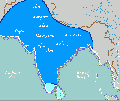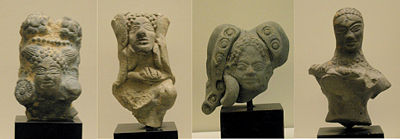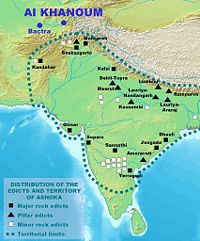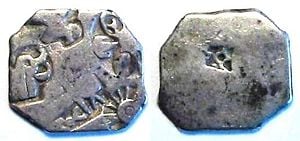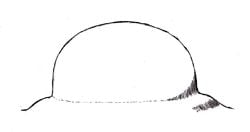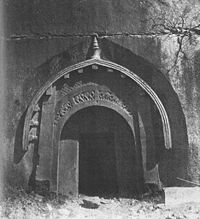Maurya Empire
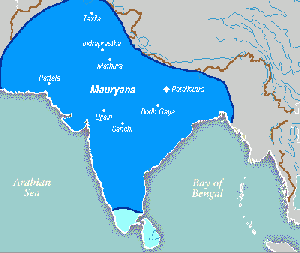 The Maurya Empire at its largest extent under Ashoka the Great. | |
| Imperial Symbol: The Lion Capital of Ashoka | |
| Founder | Chandragupta Maurya |
|---|---|
| Preceding State(s) | Nanda Dynasty of Magadha Mahajanapadas |
| Languages | Pali Prakrit Sanskrit |
| Religions | Buddhism Hinduism Jainism |
| Capital | Pataliputra |
| Head of State | Samraat (Emperor) |
| First Emperor | Chandragupta Maurya |
| Last Emperor | Brhadrata |
| Government | Centralized Absolute Monarchy with Divine Right of Kings as described in the Arthashastra |
| Divisions | 4 provinces: Tosali Ujjain Suvarnagiri Taxila Semi-independent tribes |
| Administration | Inner Council of Ministers (Mantriparishad) under a Mahamantri with a larger assembly of ministers (Mantrinomantriparisadamca). Extensive network of officials from treasurers (Sannidhatas) to collectors (Samahartas) and clerks (Karmikas). Provincial administration under regional viceroys (Kumara or Aryaputra) with their own Mantriparishads and supervisory officials (Mahamattas). Provinces divided into districts run by lower officials and similar stratification down to individual villages run by headmen and supervised by Imperial officials (Gopas). |
| Area | 5 million km² (Southern Asia and parts of Central Asia) |
| Population | 50 million [1] (one third of the world population [2]) |
| Currency | Silver Ingots (Panas) |
| Existed | 322‚Äď185 B.C.E. |
| Dissolution | Military coup by Pusyamitra Sunga |
| Succeeding state | Sunga Empire |
The Maurya Empire (322 ‚Äď 185 B.C.E.), ruled by the Mauryan dynasty, was a geographically extensive and powerful political and military empire in ancient India. Originating from the kingdom of Magadha in the Indo-Gangetic plains of modern Bihar, Eastern Uttar Pradesh and Bengal, the empire's capital city was at Pataliputra near modern Patna. Chandragupta Maurya founded the Empire in 322 B.C.E. after overthrowing the Nanda Dynasty. He began rapidly expanding his power westward across central and western India. Local powers had been disrupted by the westward withdrawal of Alexander the Great's and his Macedonian and Persian armies. By 316 B.C.E. the empire had fully occupied Northwestern India, defeating and conquering the satraps left by Alexander.
At its zenith, the Empire stretched to the northern natural boundaries of the Himalaya Mountains, and to the east into Assam. To the west, it reached beyond modern Pakistan and significant portions of Afghanistan, including the modern Herat and Kandahar provinces and Balochistan. Emperor Bindusara expanded the Empire into India's central and southern regions, but it excluded a small portion of unexplored tribal and forested regions near Kalinga, India.
The Mauryan Empire was arguably the largest empire to rule the Indian subcontinent. Its decline began fifty years after Ashoka's rule ended, and it dissolved in 185 B.C.E. with the rise of the Sunga Dynasty in Magadha. Under Chandragupta, the Mauryan Empire conquered the trans-Indus region, defeating its Macedonian rulers. Chandragupta then defeated the invasion led by Seleucus I, a Greek general from Alexander's army. Under Chandragupta and his successors internal and external trade, and agriculture and economic activities, all thrived and expanded across India. Chadragupta created a single and efficient system of finance, administration, and security. The Mauryan empire stands as one of the most significant periods in Indian history.
After the Kalinga War, the Empire experienced a half century of peace and security under Ashoka. India was a prosperous and stable empire of great economic and military power. Its political and trade influence extended across Western and Central Asia into Europe. During that time Mauryan India also enjoyed an era of social harmony, religious transformation, and expansion of learning and the sciences. Chandragupta Maurya's embrace of Jainism increased social and religious renewal and reform across his society. Ashoka's embrace of Buddhism was the foundation of social and political peace and non-violence across all of India. The era fostered the spread of Buddhist ideals into Sri Lanka, Southeast Asia, West Asia, and Mediterranean Europe.
Chandragupta's minister Kautilya Chanakya wrote the Arthashastra, considered one of the greatest treatises on economics, politics, foreign affairs, administration, military arts, war, and religion ever produced. Archaeologically, the period of Mauryan rule in Southern Asia falls into the era of Northern Black Polished Ware (NBPW). The Arthashastra and the Edicts of Ashoka serve as primary sources of written records of the Mauryan times. The Lion Capital of Asoka at Sarnath, remains the emblem of India.
Background
Alexander set up a Macedonian garrison and satrapies (vassal states) in the trans-Indus region of modern day Pakistan, ruled previously by kings Ambhi of Taxila and Porus of Pauravas (modern day Jhelum).
Chanakya and Chandragupta Maurya
Following Alexander's advance into the Punjab, a brahmin named Chanakya (real name Vishnugupt, also known as Kautilya) traveled to Magadha, a kingdom large and militarily-powerful and feared by its neighbors, but its king Dhana, of the Nanda Dynasty, dismissed him. The prospect of battling Magadha deterred Alexander's troops from going further east: He returned to Babylon, and re-deployed most of his troops west of the Indus river. When Alexander died in Babylon, soon after in 323 B.C.E., his empire fragmented, and local kings declared their independence, leaving several smaller satraps in a disunited state. Chandragupta Maurya deposed Dhana. The Greek generals Eudemus, and Peithon, ruled until around 316 B.C.E., when Chandragupta Maurya (with the help of Chanakya, now his adviser) surprised and defeated the Macedonians and consolidated the region under the control of his new seat of power in Magadha.
Mystery and controversy shrouds Chandragupta Maurya's rise to power. On the one hand, a number of ancient Indian accounts, such as the drama Mudrarakshasa (Poem of Rakshasa-Rakshasa was the prime minister of Magadha) by Visakhadatta, describe his royal ancestry and even link him with the Nanda family. the earliest Buddhist texts, Mahaparinibbana Sutta refer to a kshatriya tribe known as the Maurya.
Any conclusions require further historical evidence. Chandragupta first emerges in Greek accounts as "Sandrokottos." As a young man he may have met Alexander. Accounts say that he also met the Nanda king, angered him, and made a narrow escape. Chanakya originally intended to train a guerrilla army under Chandragupta's command. The Mudrarakshasa of Visakhadutta, as well as the Jaina work Parisishtaparvan, discuss Chandragupta's alliance with the Himalayan king Parvatka, sometimes identified with Porus. That Himalayan alliance gave Chandragupta a composite and powerful army made up of Yavanas (Greeks), Kambojas, Shakas (Scythians), Kiratas (Nepalese), Parasikas (Persians), and Bahlikas (Bactrians). With the help of those frontier martial tribes from Central Asia, Chandragupta defeated the Nanda/Nandin rulers of Magadha and founded the powerful Maurya empire in northern India.
| Approximate Dates of Mauryan Dynasty | ||||||||||||
| Emperor | Reign start | Reign end | ||||||||||
|---|---|---|---|---|---|---|---|---|---|---|---|---|
| Chandragupta Maurya | 322 B.C.E. | 298 B.C.E. | ||||||||||
| Bindusara | 297 B.C.E. | 272 B.C.E. | ||||||||||
| Asoka The Great | 273 B.C.E. | 232 B.C.E. | ||||||||||
| Dasaratha | 232 B.C.E. | 224 B.C.E. | ||||||||||
| Samprati | 224 B.C.E. | 215 B.C.E. | ||||||||||
| Salisuka | 215 B.C.E. | 202 B.C.E. | ||||||||||
| Devavarman | 202 B.C.E. | 195 B.C.E. | ||||||||||
| Satadhanvan | 195 B.C.E. | 187 B.C.E. | ||||||||||
| Brihadratha | 187 B.C.E. | 185 B.C.E. | ||||||||||
The approximate extent of the Magadha state in the fifth century B.C.E.
The Maurya Empire when first founded by Chandragupta Maurya c. 320 B.C.E., after conquering the Nanda Empire when only about twenty years old.
- Ashoka the Great extended into Kalinga during the Kalinga War c. 265 B.C.E., and established superiority over the southern kingdoms.
Conquest of Magadha
Chanakya encouraged Chandragupta and his army to take over the throne of Magadha. Using his intelligence network, Chandragupta gathered many young men from across Magadha and other provinces, men upset over the corrupt and oppressive rule of king Dhana, plus resources necessary for his army to fight a long series of battles. Those men included the former general of Taxila, other accomplished students of Chanakya, the representative of King Porus of Kakayee, his son Malayketu, and the rulers of small states.
Preparing to invade Pataliputra, Maurya hatched a plan. He had a battle announced and the Magadhan army mustered from the city to a distant battlefield to engage Maurya's forces. Maurya's general and spies meanwhile bribed the corrupt general of Nanda. He also managed to create an atmosphere of civil war in the kingdom, which culminated in the death of the heir to the throne. Chanakya managed to win over popular sentiment. Ultimately Nanda resigned, handing power to Chandragupta, went into exile and disappeared from history.
Chanakya contacted the prime minister, Rakshasa, and made him understand that he owed loyalty to Magadha rather than to the Magadha dynasty, insisting that he continue in office. Chanakya also reiterated that choosing to resist would start a war that would severely affect Magadha and destroy the city. Rakshasa accepted Chanakya's reasoning, and Chandragupta Maurya was legitimately installed as the new King of Magadha. Rakshasa became Chandragupta's chief adviser, and Chanakya assumed the position of an elder statesman.
Building India's First Empire
Having become the king of one of India's most powerful states, Chandragupta invaded the Punjab. One of Alexander's richest satraps, Peithon, satrap of Media, had tried to raise a coalition against him. Chandragupta managed to conquer the Punjab capital of Taxila, an important center of trade and Hellenistic culture, increasing his power and consolidating his control.
Chandragupta Maurya
Chandragupta again fought with the Greeks when Seleucus I, ruler of the Seleucid Empire, tried to reconquer the northwestern parts of India, during a campaign in 305 B.C.E., but failed. The two rulers finally concluded a peace treaty: A marital treaty (Epigamia), implying either a marital alliance between the two dynastic lines or a recognition of marriage between Greeks and Indians. Chandragupta received the satrapies of Paropamisadae (Kamboja and Gandhara), Arachosia (Kandhahar), and Gedrosia (Balochistan), and Seleucus I received 500 war elephants that would play a decisive role in his victory against western Hellenistic kings at the Battle of Ipsus in 301 B.C.E. Diplomatic relations established, several Greeks, such as the historian Megasthenes, Deimakos, and Dionysius, resided at the Mauryan court.
Chandragupta established a strong centralized state with a complex administration at Pataliputra, which, according to Megasthenes, was "surrounded by a wooden wall pierced by 64 gates and 570 towers‚ÄĒ(and) rivaled the splendors of contemporaneous Persian sites such as Susa and Ecbatana." Chandragupta's son Bindusara extended the rule of the Mauryan empire towards southern India. He also had a Greek ambassador, Deimachus (Strabo 1‚Äď70), at his court. Megasthenes described a disciplined multitude under Chandragupta, who live simply, honestly, and did not know writing.
Bindusara
Chandragupta died after reigning for twenty four years. His son, Bindusara, also known as Amitrochates (destroyer of foes) in Greek accounts, succeeded him in 298 B.C.E.[3] Little information regarding Bindusara exists. Still, some credit him with the incorporation of the southern peninsular India. According to Jain tradition, his mother was a woman by the name of Durdhara. The Puranas assign him a reign of twenty five years. He has been identified with the Indian title Amitraghata (slayer of Enemies), found in Greek texts as Amitrochates.
Ashoka the Great
Contemporary historians consider Chandragupta's grandson Ashokavardhan Maurya, better known as Ashoka (ruled 273-232 B.C.E.), as perhaps the greatest of Indian monarchs, and perhaps the world. H.G. Wells calls him the "greatest of kings."
As a young prince, Ashoka served as a brilliant commander who crushed revolts in Ujjain and Taxila. As an ambitious and aggressive monarch, he re-asserted the Empire's superiority in southern and western India. But his conquest of Kalinga proved the pivotal event of his life. Although Ashoka's army succeeded in overwhelming Kalinga forces of royal soldiers and civilian units, an estimated 100,000 soldiers and civilians died in the furious warfare, including over 10,000 of Ashoka's own men. Hundreds of thousands of people became refugees. When he personally witnessed the devastation, Ashoka began feeling remorse, and he cried, "what have I done?" Although the annexation of Kalinga was completed, Ashoka embraced the teachings of Gautama Buddha, and renounced war and violence. For a monarch in ancient times, this was an historic feat. After Ashoka's renunciation of war to acquire territory, he established friendly relations with the three Tamil dynasties of Chola, Chera and Pandya (known as Tamilakam or "Land of Tamils") at the southern tip of India, the only territory in India not directly under his control.
Ashoka implemented principles of ahimsa by banning hunting and violent sports activity and ending indentured and forced labor (many thousands of people in war-ravaged Kalinga had been forced into hard labor and servitude). While he maintained a large and powerful army, to keep the peace and maintain authority, Ashoka expanded friendly relations with states across Asia and Europe, and he sponsored Buddhist missions. He undertook a massive public works building campaign across the country. Over forty years of peace, harmony and prosperity made Ashoka one of the most successful and famous monarchs in Indian history. He remains an idealized figure of inspiration in modern India.
The Edicts of Ashoka, set in stone, have been found throughout the Subcontinent. Ranging from as far west as Afghanistan and as far south as Andhra (Nellore District), Ashoka's edicts state his policies and accomplishments. Although written for the most part in Prakrit, two of them had been written in Greek, and one in both Greek and Aramaic. Ashoka's edicts refer to the Greeks, Kambojas, and Gandharas as peoples forming a frontier region of his empire. They also attest to Ashoka's having sent envoys to the Greek rulers in the West as far as the Mediterranean. The edicts precisely name each of the rulers of the Hellenic world at the time such as Amtiyoko (Antiochus), Tulamaya (Ptolemy), Amtikini (Antigonos), Maka (Magas) and Alikasudaro (Alexander) as recipients of Ashoka's proselytism. The Edicts also accurately locate their territory "600 yojanas away" (a yojanas being about seven miles), corresponding to the distance between the center of India and Greece (roughly 4,000 miles).[5]
Administration
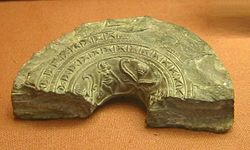
The Empire divided into four provinces, with the imperial capital at Pataliputra. From Ashokan edicts, the names of the four provincial capitals follow: Tosali (in the east), Ujjain in the west, Suvarnagiri (in the south), and Taxila (in the north). The head of the provincial administration had been the Kumara (royal prince), who governed the provinces as king's representative. Mahamatyas and council of ministers assisted the kumara. That organizational structure mirrored the imperial level with the Emperor and his Mantriparishad (Council of Ministers).
Historians theorize that the organization of the Empire was in line with the extensive bureaucracy described by Kautilya in the Arthashastra: A sophisticated civil service governed everything from municipal hygiene to international trade. The expansion and defense of the empire was made possible by what appears to have been the largest standing army of its time.[6] According to Megasthenes, the empire wielded a military of 600,000 infantry, 30,000 cavalry, and 9,000 war elephants. A vast espionage system collected intelligence for both internal and external security purposes. Having renounced offensive warfare and expansionism, Ashoka nevertheless continued to maintain that large army, to protect the Empire and instill stability and peace across West and South Asia.[7]
Economy
For the first time in South Asia, political unity and military security allowed for a common economic system and enhanced trade and commerce, with increased agricultural productivity. The previous situation involving hundreds of kingdoms, many small armies, powerful regional chieftains, and internecine warfare, gave way to a disciplined central authority. Farmers were freed of tax and crop collection burdens from regional kings, paying instead to a nationally-administered and strict-but-fair system of taxation as advised by the principles in the Arthashastra. Chandragupta Maurya established a single currency across India, and a network of regional governors and administrators and a civil service provided justice and security for merchants, farmers and traders. The Mauryan army wiped out many gangs of bandits, regional private armies, and powerful chieftains who sought to impose their own supremacy in small areas. Although regimental in revenue collection, Maurya also sponsored many public works and waterways to enhance productivity, while internal trade in India expanded greatly due to newfound political unity and internal peace.
Under the Indo-Greek friendship treaty, and during Ashoka's reign, an international network of trade expanded. The Khyber Pass, on the modern boundary of Pakistan and Afghanistan, became a strategically-important port of trade and intercourse with the outside world. Greek states and Hellenic kingdoms in West Asia became important trade partners of India. Trade also extended through the Malay peninsula into Southeast Asia. India's exports included silk goods and textiles, spices, and exotic foods. An exchange of scientific knowledge and technology with Europe and West Asia enriched the Empire further. Ashoka also sponsored the construction of thousands of roads, waterways, canals, hospitals, rest-houses, and other public works. The easing of many overly-rigorous administrative practices, including those regarding taxation and crop collection, helped increase productivity and economic activity across the Empire.
In many ways, the economic situation in the Maurya Empire compares to the Roman Empire several centuries later, both having extensive trade connections and organizations similar to corporations. While Rome had organizational entities largely used for public state-driven projects, Mauryan India had numerous private commercial entities which existed purely for private commerce. The Mauryas had to contend with pre-existing private commercial entities, hence their concern about keeping the support of those pre-existing organizations. The Romans lacked such pre-existing entities.[8]
Religion

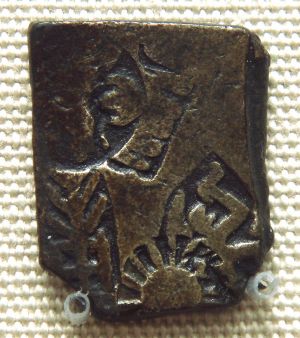
Jainism
Emperor Chandragupta Maurya became the first major Indian monarch to initiate a religious transformation at the highest level when he embraced Jainism, a religious movement resented by orthodox Hindu priests who usually attended the imperial court. At an older age, Chandragupta renounced his throne and material possessions to join a wandering group of Jain monks. Chandragupta became a disciple of Acharya Bhadrabahu. In his last days, he observed the rigorous but self purifying Jain ritual of santhara i.e. fast unto death, at Shravan Belagola in Karnatka. His successor, Emperor Bindusara, preserved Hindu traditions and distanced himself from Jain and Buddhist movements.Samprati, the grandson of Ashoka also embraced Jainism.
Samrat Samprati had been influenced by the teachings of Jain monk Arya Suhasti Suri, building many Jain Temples across India. Some of them still stand in towns of Ahmedabad, Viramgam, Ujjain & Palitana. Just like Ashoka, Samprati sent messengers & preachers to Greece, Persia & Middle-East for the spread of Jainism. But till date no research has been done in this area. Thus, Jainism became a vital force under the Mauryan Rule. Chandragupta & Samprati, are credited for spread of Jainism in Southern India. Lakhs of Jain Temples & Jain Stupas were erected during their reign. But due to lack of royal patronage & its strict principles, along with rise of Shankaracharya & Ramanujacharya, Jainism, once the major religion of southern India, declined.
Buddhism
But when Ashoka embraced Buddhism, following the Kalinga War, he renounced expansionism and aggression, and the harsher injunctions of the Arthashastra on the use of force, intensive policing, and ruthless measures for tax collection and against rebels. Ashoka sent a mission led by his son and daughter to Sri Lanka, whose king Tissa adopted Buddhist ideals, making Buddhism the state religion. Ashoka sent many Buddhist missions to West Asia, Greece and South East Asia, and commissioned the construction of monasteries, schools and publication of Buddhist literature across the empire. He built as many as 84,000 stupas across India, and increased the popularity of Buddhism in Afghanistan. Ashoka helped convene the Third Buddhist Council of India and South Asia's Buddhist orders, near his capital, a council that undertook much work of reform and expansion of the Buddhist religion.
Buddhism continued to thrive after Ashoka for nearly 600 years until a combination of events eclipsed the faith into near annihilation in India. First, Buddhism declined in the wake of the invasion of the White Huns during the fifth century C.E. The decline accelerated in the twelfth century C.E. with the fall of the Pala dynasty and Muslim destruction of temples and monasteries. Second, a golden age of Sanskrit during the Gupta dynasty (fourth to sixth centuries C.E.), that restructured and revitalized Gupta civilization in accord with Hinduism, forced Buddhism into recession.
Hinduism
While himself a Buddhist, Ashoka retained the membership of Hindu priests and ministers in his court, and he maintained religious freedom and tolerance although the Buddhist faith grew in popularity with his patronage. Indian society began embracing the philosophy of ahimsa, and given the increased prosperity and improved law enforcement, crime and internal conflicts reduced dramatically. Due to Buddhism's and Jainism's inherent anti-caste teaching and philosophy, the caste system and traditional practice of discrimination among the social groups fell into disfavor as Hinduism began absorbing the ideals and values of Jain and Buddhist teachings. Social freedom began expanding in an age of peace and prosperity.
Architectural remains
Few architectural remains of the Maurya period have been found. Remains of a hypostyle building with about eighty columns of a height of about ten meters have been found in Kumhrar, five kilometers from Patna Railway station, one of the few sites Mauryas located. The style resembles Persian Achaemenid architecture.[9]
The grottoes of Barabar Caves provide another example of Mauryan architecture, especially the decorated front of the Lomas Rishi grotto. The Mauryas offered those to the Buddhist sect of the Ajivikas.[9] The Pillars of Ashoka, often exquisitely decorated, constitute outstanding examples of Maurya architecture with more than forty spread throughout the sub-continent.
Decline
Ashoka was followed for fifty years by a succession of weaker kings. Brhadrata, the last ruler of the Mauryan dynasty, held territories that had shrunk considerably from the time of emperor Ashoka, although he still upheld the Buddhist faith.
Sunga coup (185 B.C.E.)
Brhadrata was assassinated in 185 B.C.E. during a military parade by the commander-in-chief of his guard, the Brahmin general Pusyamitra Sunga, who then took over the throne and established the Sunga dynasty. Buddhist records such as the Asokavadana reveal that the assassination of Brhadrata and the rise of the Sunga empire led to a wave of persecution for Buddhists, and a resurgence of Hinduism. Pusyamitra may have been the main instigator of the persecutions, although later Sunga kings seem to have been more supportive of Buddhism.[10] Other historians point to a lack of archaeological evidence supporting the claim of persecution of Buddhists.[11][12]
Establishment of the Indo-Greek Kingdom (180 B.C.E.)
The fall of the Mauryas left the Khyber Pass unguarded, and a wave of invasions followed. The Greco-Bactrian king, Demetrius, capitalizing on the break-up, he conquered southern Afghanistan and Pakistan around 180 B.C.E., forming the Indo-Greek Kingdom. The Indo-Greeks maintained control the trans-Indus region, conducting campaigns into central India, for about a century. Buddhism flourished under them, one of their kings Menander becoming a key promoter of Buddhism. He established the new capital of Sagala, the modern city of Sialkot. The extent of their domains, and the length of their rule, remain unclear. Numismatic evidence indicates that they controlled territory in the subcontinent until the beginning of the Common Era. The Scythian tribes, renamed Indo-Scythians, brought about the demise of the Indo-Greeks in 70 B.C.E., seizing the region of Mathura, and Gujarat.
| Preceded by: Nanda Dynasty |
Magadha dynasties |
Succeeded by: Sunga dynasty |
Notes
- ‚ÜĎ Roger Boesche, "Kautilya‚Äôs Arthashastra on War and Diplomacy in Ancient India", The Journal of Military History 67 (2003): 12.
- ‚ÜĎ Colin McEvedy and Richard Jones, "Atlas of World Population History", Facts on File (1978): 342-351.
- ‚ÜĎ Nilakantha Shastri, Age of the Nandas and Mauryas (Delhi, Motilal Banarsidass, 1967).
- ‚ÜĎ Burjor Avari, India: The Ancient Past (Routledge, ISBN 0415356156).
- ‚ÜĎ S. Dhammika, Edicts of Ashoka, 13th Rock Edict.
- ‚ÜĎ Sarat Chandra Roy, Man in India (Calcutta: A.K. Bose, 1921).
- ‚ÜĎ Romesh Chunder Dutt, Vincent Arthur Smith, Stanley Lane-Poole, Stanley Lane-Poole, H. M. Elliot, William Wilson Hunter, William Wilson Hunter, Alfred Comyn Lyall, and A. V. Williams Jackson, History of India (London: Grolier Society, 1906), 204.
- ‚ÜĎ Vikramaditya S. Khanna, "The Economic History of the Corporate Form in Ancient India." November 1, 2005. Retrieved September 22, 2016.
- ‚ÜĎ 9.0 9.1 Thierry Z√©phir, L'√Ęge d'or de l'Inde classique (RMN, 2007, ISBN 978-2711852895)
- ‚ÜĎ Sir John Marshall, A Guide to Sanchi (Eastern Book House, 1990, ISBN 8185204322), 38.
- ‚ÜĎ E. Lamotte, History of Indian Buddhism (Institut Orientaliste: Louvain-la-Neuve 1988).
- ‚ÜĎ Romila Thapar, Asoka and the Decline of the Mauryas (Oxford University Press, 1960), 200.
ReferencesISBN links support NWE through referral fees
- Avari, Burjor. India, the Ancient Past: A History of the Indian Sub-Continent from c. 7000 B.C.E. to AD 1200. London: Routledge, 2007. ISBN 978-0415356152.
- Fuller, J. F. C. The Generalship of Alexander the Great. New York, NY: Da Capo Press, 2004. ISBN 978-0306813306.
- Jackson, A. V. Williams, Romesh Chunder Dutt, Vincent Arthur Smith, Stanley Lane-Poole, H. M. Elliot, William Wilson Hunter, and Alfred Comyn Lyall. History of India. New Delhi: Asian Educational Services, 1987. OCLC 50629155
- KauŠĻ≠alya, and L. N. Rangarajan. The Arthashastra. New Delhi: Penguin Books India, 1992. ISBN 978-0140446036.
- Lamotte, √Čtienne. History of Indian Buddhism from the Origins to the Ňöaka era. Louvain-la-Neuve: Inst. Orientaliste, 1988. ISBN 978-9068311006.
- Marshall, John Hubert. A Guide to Sanchi. Calcutta: Superintendent Government Printing, India, 1918. OCLC 4837154
- Mookerji, Radhakumud. Chandragupta Maurya and his Times. Delhi: Motilal Banarsidass, 1966. ISBN 978-8120804050.
- Morkot, Robert. The Penguin Historical Atlas of Ancient Greece. London, England: Penguin Books, 1996. ISBN 978-0140513356.
- Roy, Sarat Chandra. Man in India. Calcutta: A.K. Bose, 1921. OCLC 32931485
- Shastri, Nilakantha. Age of the Nandas and Mauryas. Delhi, Motilal Banarsidass, 1967.
- Thapar, Romila. AŇõoka and the Decline of the Mauryas. London: Oxford University Press, 1961. OCLC 736554
- Z√©phir, Thierry. L'√Ęge d'or de l'Inde classique. RMN, 2007. ISBN 978-2711852895
External links
All links retrieved April 29, 2025.
| |||||||||||
Credits
New World Encyclopedia writers and editors rewrote and completed the Wikipedia article in accordance with New World Encyclopedia standards. This article abides by terms of the Creative Commons CC-by-sa 3.0 License (CC-by-sa), which may be used and disseminated with proper attribution. Credit is due under the terms of this license that can reference both the New World Encyclopedia contributors and the selfless volunteer contributors of the Wikimedia Foundation. To cite this article click here for a list of acceptable citing formats.The history of earlier contributions by wikipedians is accessible to researchers here:
The history of this article since it was imported to New World Encyclopedia:
Note: Some restrictions may apply to use of individual images which are separately licensed.
